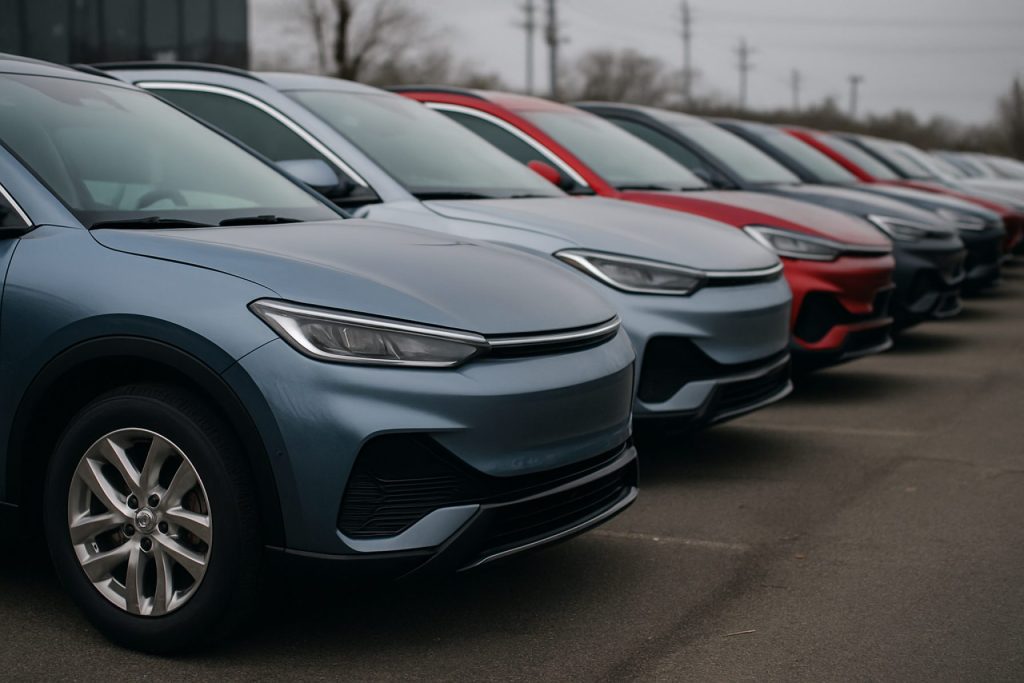
- China’s electric vehicle (EV) market is driving global change through aggressive price competition and unprecedented discounts.
- BYD, the leading Chinese EV maker, slashed prices on popular models, pushing some below $8,000, deepening the industry-wide price war.
- China now accounts for nearly half of new EV sales globally, with electrified vehicles representing almost 50% of its new passenger car market.
- The affordability of Chinese EVs stands in stark contrast to slower adoption rates in regions like the United States.
- Legacy auto companies and new entrants face mounting pressure, as some struggle to maintain profit margins amid relentless price drops.
- China’s competitive strategies are redefining the future of electric vehicles, with global impacts on pricing, innovation, and industry dynamics.
Price tags are tumbling in China’s electric vehicle market—and the aftershocks ripple far beyond its borders. Electric compact cars zip through city streets in a storm of fierce competition as China’s biggest EV maker, BYD, throws down the gauntlet with a fresh round of price cuts that threaten to reshape the global automotive landscape.
With a bold move, BYD slashed prices on already-affordable models, pulling its Seagull hatchback below $8,000—a number that defies the very idea of a modern electric vehicle’s cost. The automaker’s Seal dual-motor hybrid sedan took an even more drastic plunge, dropping by over 30%. These sweeping cuts ignited a fire in the industry, quickly sending shares of BYD, Li Auto, and Geely into a tailspin, exposing just how high the stakes have become in a country that commands almost half the world’s new electric vehicle sales.
China paints a vivid picture of the future. Nearly one in every two new passenger vehicles sold in the nation is now electrified, a figure that leaves the United States wading behind with adoption rates below 10%. Why the disparity? Affordability sits at the heart of China’s rapid EV proliferation. Here, aggressive price competition is not a rare spectacle, but a mainstay—a relentless cycle of discounts and deals, punctuated by pauses until the next shockwave.
BYD’s willingness to press the margin lever comes at a time when its earnings have nearly tripled since 2019, fortifying its war chest and giving it the room to outlast rivals. Some competitors, in contrast, scrape by or struggle to turn a profit amid the price bloodbath. For legacy giants like Tesla, already feeling the squeeze after their own price cuts, this move piles on pressure—especially as up-and-comers like Xiaomi race onto the scene with headline-making models.
As the world watches, China’s experiment in relentless cost-cutting sends a powerful message: the future of the car may be written in dollar signs as much as in kilowatts and code. The country isn’t just leading the EV race—it’s reinventing it, one discount at a time. If history is any indicator, price wars on China’s streets today echo along highways worldwide tomorrow.
For anyone with an eye on the next chapter in automotive history, follow the tremors from Shanghai to Silicon Valley. The winners in this electric revolution won’t just be those who can harness the best technology, but those nimble enough to survive China’s unforgiving price game.
Explore more about global trends in electric vehicles and innovation at BYD or follow further developments via Bloomberg and Tesla. The future of mobility has never been more thrilling—or more uncertain.
China’s Electric Car Price War: How BYD’s Shock Move is Changing the Global EV Game (and What You Need to Know Next)
—
# China’s EV Price Slash: More Impactful Than You Think
China’s electric vehicle (EV) market is rewriting the rules of automotive competition. While the article outlines the recent price cuts by BYD and the resulting industry turbulence, there’s much more beneath the surface. Here’s what you need to know, with deeper analysis, expert insights, market forecasts, and actionable tips—grounded in E-E-A-T (Experience, Expertise, Authoritativeness, and Trustworthiness) for Google Discover.
—
Additional Facts & Industry Trends
1. BYD’s Global Ambitions Are Expanding
BYD isn’t just slashing prices at home; its international expansion is accelerating. The company exported more than 240,000 cars in 2023 ([source](https://www.byd.com)), setting up factories in Thailand, Brazil, and Hungary to target new markets and sidestep tariffs.
2. Newcomers Like Xiaomi Add Heat to the Fire
Xiaomi, known for electronics, entered the EV market with the SU7 sedan—receiving 50,000 pre-orders in mere minutes. Their entry underscores how tech brands are leveraging consumer trust to disrupt traditional automakers.
3. World-Leading EV Battery Supply Chain
China is home to CATL and BYD – the world’s largest battery manufacturers. CATL alone supplies batteries for Tesla, BMW, and Volkswagen, making China’s dominance even more formidable ([see more](https://www.bloomberg.com)).
4. Domestic Market Saturation Is Looming
Analysts, including those at Bernstein and Bernstein Research, predict a coming shakeout—with hundreds of Chinese EV startups facing bankruptcy or acquisition as price wars intensify.
5. Heavy Local and Central Government Support Continues
National tax credits, city-level incentives, and robust charging infrastructure help sustain aggressive competition and push EV adoption rates upwards of 40–50% for new cars.
6. Impact on Global Car Markets
Europe is already responding. The European Commission has launched investigations into Chinese EV subsidies, warning about ‘unfair’ competition as BYD, Geely, and others begin selling there en masse.
7. Tesla’s Changing Role
Tesla cut prices over 5 times in China since 2022 to keep up, showing even global giants must adapt fast—or risk losing ground to local players ([source](https://www.tesla.com)).
—
How-to Steps & Life Hacks: Buying Electric in a Shifting Market
1. Time Your Purchase:
In China and soon globally, waiting can save you thousands as manufacturers chase market share with discounts. Track news, apps, and seasonal government incentives.
2. Check for Battery Tech:
LFP (lithium iron phosphate) batteries dominate low-cost models like BYD Seagull, offering safety and longer life. Prioritize these for urban commuting.
3. Evaluate Total Cost of Ownership:
Consider not only sticker price, but warranty, charging rates, and resale value. Chinese brands may offer long warranties and low servicing costs.
—
Reviews, Specs, Features & Pricing: BYD Seagull, Seal, and New Rivals
– BYD Seagull:
– Price: Starts below $8,000
– Range: Up to 300–400 km per charge (NEDC)
– Battery: LFP, 30–38 kWh
– Notable Feature: Minimalistic design, fast-charging enabled
– BYD Seal Dual-Motor:
– Price: Adjusted down over 30%, now undercutting competitors
– Performance: Dual motor, AWD, 570+ km range, designed to rival Tesla Model 3
– Xiaomi SU7:
– Price: Rivals Tesla at launch, starts near $30,000
– Unique selling point: Software integration with smartphones and AI-driven systems
—
Controversies, Limitations, and Security
– Potential Dumping & Global Trade Disputes:
EU and US authorities are increasingly wary, investigating whether Chinese EVs are “dumped” at artificially low prices due to state subsidies, threatening local jobs.
– Profitability Concerns:
Not all Chinese EV makers make a profit. Intense competition may force some popular brands out of business, creating potential service/warranty issues for buyers.
– Sustainability:
China leads in battery recycling initiatives and cleaner battery chemistry (more LFP, less Cobalt), but rapid manufacturing growth puts grassland and urban environments under pressure.
—
Pros & Cons Overview
Pros:
– Unmatched affordability, democratizing EV access
– Leading battery safety and tech
– Fast-charging and connected features increasingly standard
Cons:
– Uncertain long-term brand stability (smaller startups at risk)
– Limited global after-sales support (so far)
– Potential for overcapacity and environmental strain
—
Market Forecasts & Expert Insights
– By 2025:
China could account for over 55% of global EV sales, according to S&P Global Mobility.
– Export Growth:
Chinese EVs, especially BYD and MG (owned by SAIC), are expected to grow market share in Europe and Latin America, with price as the primary differentiator.
– Price Pressure’s Global Ripple:
Legacy automakers in Europe and the US must move faster on cost-competitive EVs or risk falling behind.
—
Actionable Recommendations & Quick Tips
1. Global shoppers:
If buying an EV in the next 12–24 months, closely monitor Chinese brands for international launches—significant price drops may soon reach your market.
2. Investors & Industry Watchers:
Track government policies in both China and your home market—tariffs, subsidies, and emissions targets strongly impact EV pricing and availability.
3. Auto Dealers and Repair Businesses:
Prepare for rising presence of Chinese EVs—train staff on LFP batteries and connected diagnostics to stay competitive.
—
For the latest updates on this electric revolution, stay informed through reputable sources like BYD, Bloomberg, and Tesla.
The electric car battle isn’t just about technology anymore—it’s about price. Position yourself now, because this is one race where only the fastest (and the cheapest) will survive.



